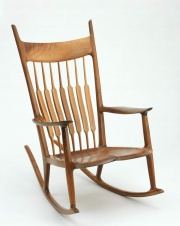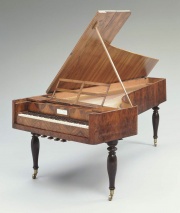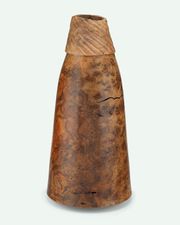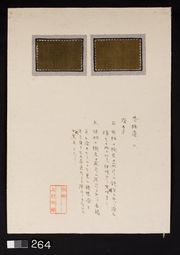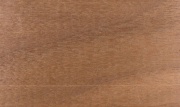Difference between revisions of "Walnut"
(username removed) |
|||
| (12 intermediate revisions by 3 users not shown) | |||
| Line 1: | Line 1: | ||
| − | [[File:1976.122-SC28639.jpg|thumb| | + | [[File:1976.122-SC28639.jpg|thumb|Rocking chair<br>MFA#: 1976.122]] |
== Description == | == Description == | ||
| − | + | [[File:1982.178-SC14541.jpg|thumb|Grand piano<br>MFA Acc#: 1982.178]] | |
Strong, valuable, hardwood trees of the genus ''Juglans'' native to the temperate climates of the northern hemisphere. Walnut trees have fine-grain, uniform wood that polishes to a high gloss. They are used for furniture, painting panels, frames, sculptures, veneer, piano cases, carving, and gun stocks. A drying oil is pressed from the nut kernels and is used in artist paints. Ground nut shells are used as a filler in plastics and as a soft abrasive. A dark brown dye can also be extracted from the nut shells. | Strong, valuable, hardwood trees of the genus ''Juglans'' native to the temperate climates of the northern hemisphere. Walnut trees have fine-grain, uniform wood that polishes to a high gloss. They are used for furniture, painting panels, frames, sculptures, veneer, piano cases, carving, and gun stocks. A drying oil is pressed from the nut kernels and is used in artist paints. Ground nut shells are used as a filler in plastics and as a soft abrasive. A dark brown dye can also be extracted from the nut shells. | ||
| − | + | [[File:1985.36-SC58786.jpg|thumb|Wood-turning<br>MFA Acc#: 1985.36]] | |
| − | + | * American or [[black%20walnut%20|black walnut ]] (''J. nigra''): native to the eastern U.S. | |
| − | + | * [[Butternut|Butternut]] or white walnut (''J. cinerea''): native to the eastern U.S. | |
| − | + | * California walnut (''J. californica''): native to the western U.S. | |
| − | + | * [[English%20walnut|English]], Circassian, Persian, French walnut (''J. regia''): native to Eurasia | |
| − | + | * Chinese walnut (''J. cathayensis''): native to Asia | |
| − | |||
| − | - | + | [[File:Uemura 08-13-2009 264.jpg|thumb|Silk dyed with walnut bark; Uemera Dye Archive]] |
| + | [[File:walnut tangential view.jpg|thumb|Walnut, tangential view]] | ||
| + | * See also [[https://cameo.mfa.org/wiki/Kurumi_(Walnut)_-_right_(265_R) '''Uemera Dye Archive''' (Kurumi)]] | ||
| − | |||
== Synonyms and Related Terms == | == Synonyms and Related Terms == | ||
| − | noyer (Fr.); Walnuss (Deut.); noce (It.); nogueira (Port.); nogal (Esp.); | + | noyer (Fr.); Walnuss (Deut.); noce (It.); nogueira (Port.); nogal (Esp.); black walnut (''Juglans nigra''); Queen Ann's cabinet wood; Butternut or white walnut (''J. cinerea)''; California walnut (''Juglans californica''); English walnut (Circassian walnut, Persian walnut, French walnut (''Juglans regia''); Chinese walnut (''Juglans cathayensis'') |
| − | + | == Collection Risks == | |
| − | |||
| − | |||
| − | |||
| − | |||
| − | |||
| − | + | '''Links to Oddy Test results posted on AIC Wiki Materials Database Pages for individual materials below''' | |
| − | + | ° [http://www.conservation-wiki.com/wiki/Oddy_Test_Results:_Case_Construction_Materials#Walnut0001 Walnut] Tested in 2012 | |
| − | |||
| − | |||
| − | |||
| + | ° [http://www.conservation-wiki.com/wiki/Oddy_Test_Results:_Case_Construction_Materials#Walnut0002 Walnut] Tested in 2012 for comparison to coated Walnut wood | ||
| − | == | + | == Physical and Chemical Properties == |
| + | * Height: 30-40 me | ||
| + | * Bark: grey-black with deeply furrowed, thin ridges in a diamond pattern | ||
| + | * Leaves: pinnately compound alternating on stem with 15-23 leaflets. Stem is 20-60 cm long | ||
| + | * Density = 40-50 ppcf | ||
| + | * Fruit: nuts ripen in late summer/fall with a greenish brown husk encasing a brown nut | ||
| + | == Resources and Citations == | ||
| + | * Alden Identification Services, Microscopic Wood Identification: [https://wood-identification.com/wood-types/ Link] | ||
* G.S.Brady, ''Materials Handbook'', McGraw-Hill Book Co., New York, 1971 Comment: p. 856 | * G.S.Brady, ''Materials Handbook'', McGraw-Hill Book Co., New York, 1971 Comment: p. 856 | ||
| − | |||
* Ralph Mayer, ''A Dictionary of Art Terms and Techniques'', Harper and Row Publishers, New York, 1969 (also 1945 printing) | * Ralph Mayer, ''A Dictionary of Art Terms and Techniques'', Harper and Row Publishers, New York, 1969 (also 1945 printing) | ||
| − | |||
* Hermann Kuhn, ''Conservation and Restoration of Works of Art and Antiquities'', Butterworths, London, 1986 | * Hermann Kuhn, ''Conservation and Restoration of Works of Art and Antiquities'', Butterworths, London, 1986 | ||
| − | |||
* F. H. Titmuss, ''Commercial Timbers of the World'', The Technical Press Ltd., London, 1965 Comment: 40-50 ppcf | * F. H. Titmuss, ''Commercial Timbers of the World'', The Technical Press Ltd., London, 1965 Comment: 40-50 ppcf | ||
| − | |||
* ''Dictionary of Building Preservation'', Ward Bucher, ed., John Wiley & Sons, Inc., New York City, 1996 | * ''Dictionary of Building Preservation'', Ward Bucher, ed., John Wiley & Sons, Inc., New York City, 1996 | ||
| − | |||
* Pam Hatchfield, ''Pollutants in the Museum Environment'', Archetype Press, London, 2002 | * Pam Hatchfield, ''Pollutants in the Museum Environment'', Archetype Press, London, 2002 | ||
| − | |||
* ''Van Nostrand's Scientific Encyclopedia'', Douglas M. Considine (ed.), Van Nostrand Reinhold, New York, 1976 | * ''Van Nostrand's Scientific Encyclopedia'', Douglas M. Considine (ed.), Van Nostrand Reinhold, New York, 1976 | ||
| − | |||
* Random House, ''Webster's Encyclopedic Unabridged Dictionary of the English Language'', Grammercy Book, New York, 1997 | * Random House, ''Webster's Encyclopedic Unabridged Dictionary of the English Language'', Grammercy Book, New York, 1997 | ||
| − | |||
* ''The American Heritage Dictionary'' or ''Encarta'', via Microsoft Bookshelf 98, Microsoft Corp., 1998 | * ''The American Heritage Dictionary'' or ''Encarta'', via Microsoft Bookshelf 98, Microsoft Corp., 1998 | ||
| − | |||
* ''CRC Handbook of Chemistry and Physics'', Robert Weast (ed.), CRC Press, Boca Raton, Florida, v. 61, 1980 Comment: density=40-43 ppcf (0.64-0.70 g/cm3) | * ''CRC Handbook of Chemistry and Physics'', Robert Weast (ed.), CRC Press, Boca Raton, Florida, v. 61, 1980 Comment: density=40-43 ppcf (0.64-0.70 g/cm3) | ||
| + | * Wikipedia: https://en.wikipedia.org/wiki/Juglans_nigra (Accessed October 2020) | ||
| − | + | [[Category:Materials database]][[Category:MWG]][[Category: Wood]] | |
| − | |||
| − | [[Category:Materials database]] | ||
Latest revision as of 11:31, 2 October 2024
Description
Strong, valuable, hardwood trees of the genus Juglans native to the temperate climates of the northern hemisphere. Walnut trees have fine-grain, uniform wood that polishes to a high gloss. They are used for furniture, painting panels, frames, sculptures, veneer, piano cases, carving, and gun stocks. A drying oil is pressed from the nut kernels and is used in artist paints. Ground nut shells are used as a filler in plastics and as a soft abrasive. A dark brown dye can also be extracted from the nut shells.
- American or Black walnut (J. nigra): native to the eastern U.S.
- Butternut or white walnut (J. cinerea): native to the eastern U.S.
- California walnut (J. californica): native to the western U.S.
- English, Circassian, Persian, French walnut (J. regia): native to Eurasia
- Chinese walnut (J. cathayensis): native to Asia
- See also [Uemera Dye Archive (Kurumi)]
Synonyms and Related Terms
noyer (Fr.); Walnuss (Deut.); noce (It.); nogueira (Port.); nogal (Esp.); black walnut (Juglans nigra); Queen Ann's cabinet wood; Butternut or white walnut (J. cinerea); California walnut (Juglans californica); English walnut (Circassian walnut, Persian walnut, French walnut (Juglans regia); Chinese walnut (Juglans cathayensis)
Collection Risks
Links to Oddy Test results posted on AIC Wiki Materials Database Pages for individual materials below
° Walnut Tested in 2012
° Walnut Tested in 2012 for comparison to coated Walnut wood
Physical and Chemical Properties
- Height: 30-40 me
- Bark: grey-black with deeply furrowed, thin ridges in a diamond pattern
- Leaves: pinnately compound alternating on stem with 15-23 leaflets. Stem is 20-60 cm long
- Density = 40-50 ppcf
- Fruit: nuts ripen in late summer/fall with a greenish brown husk encasing a brown nut
Resources and Citations
- Alden Identification Services, Microscopic Wood Identification: Link
- G.S.Brady, Materials Handbook, McGraw-Hill Book Co., New York, 1971 Comment: p. 856
- Ralph Mayer, A Dictionary of Art Terms and Techniques, Harper and Row Publishers, New York, 1969 (also 1945 printing)
- Hermann Kuhn, Conservation and Restoration of Works of Art and Antiquities, Butterworths, London, 1986
- F. H. Titmuss, Commercial Timbers of the World, The Technical Press Ltd., London, 1965 Comment: 40-50 ppcf
- Dictionary of Building Preservation, Ward Bucher, ed., John Wiley & Sons, Inc., New York City, 1996
- Pam Hatchfield, Pollutants in the Museum Environment, Archetype Press, London, 2002
- Van Nostrand's Scientific Encyclopedia, Douglas M. Considine (ed.), Van Nostrand Reinhold, New York, 1976
- Random House, Webster's Encyclopedic Unabridged Dictionary of the English Language, Grammercy Book, New York, 1997
- The American Heritage Dictionary or Encarta, via Microsoft Bookshelf 98, Microsoft Corp., 1998
- CRC Handbook of Chemistry and Physics, Robert Weast (ed.), CRC Press, Boca Raton, Florida, v. 61, 1980 Comment: density=40-43 ppcf (0.64-0.70 g/cm3)
- Wikipedia: https://en.wikipedia.org/wiki/Juglans_nigra (Accessed October 2020)
